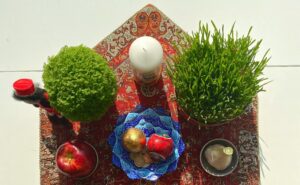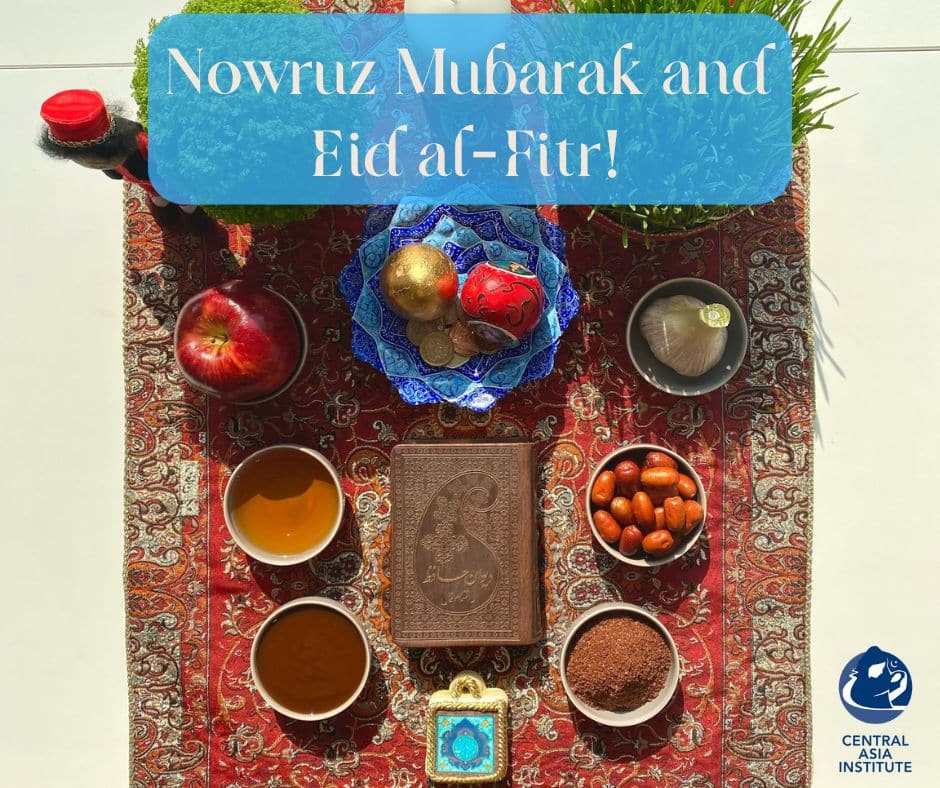Central Asia Institute wishes all who celebrate a Happy Nowruz Mubarak, or beginning of Spring, and a joyful Eid al-Fitr!
By Bella Pich
Have you ever wondered how Central Asia celebrates Nowruz Mubarak and Eid al-Fitr?
Nowruz, meaning “New Day”, is the Persian New Year celebrated on the spring equinox, marking the beginning of spring and the start of the new year in the Persian calendar. This festival, which is over 3,000 years old, has roots in Zoroastrianism, and symbolizes revival, rebirth, and hope for prosperity. Nowruz is observed by an estimated 300 million people across the globe including the countries where CAI works.
Although there are many traditions associated with Nowruz, food is a large part of the festivities. Rather than a single main dish, Nowruz features an array of foods, including the Half-sin table spread, Haft Mewa, and Sumanak, shown below.

Photo Credit: Pouya Jabbarisani
For Afghans, one of the true symbols of the New Year is a simple dish called Haft Mewa, which includes a mixture of seven different nuts and fruits. Traditionally Haft Mewa ingredients are black and yellow raisins, senjid (the dried fruit of the oleaster tree), pistachios, walnuts, almonds, and dried apricot. Not only is it delicious, but it’s an expression of hope, resilience and an unwavering belief in fresh beginnings. It’s a must have to ring in the Afghan New Year!
In Pakistan, Nowruz is celebrated by Ismaili, Shia, and some Hazara and Baloch communities. The themes of purity and rebirth are central to the celebrations, reflected in activities such as cleaning, sewing new clothes, planting trees, and decorating eggs. On the day before Nowruz, it’s common to visit the graves of relatives to honor and remember loved ones who have passed. Similar to traditions in Iran and Afghanistan, families come together to share a celebratory meal. In Pakistan, Samani is one of the featured dishes and is made from wheat. Colored eggs are also a staple food item that symbolizes each family member. At least seven dishes are served at these celebratory gatherings.
Finally, in Tajikistan, Sumanak (also known as sumalak) is a type of ritual food made from germinated wheat grains and is the most common dish served by Tajiks. Men are not allowed to partake in the ritual ceremony related to preparing the Sumanak, as it’s believed their presence would be a bad omen. The long process of Sumanak cooking usually includes singing, music, and poetry.
Central Asia Institute also extends warm wishes for a Happy Eid al-Fitr!
Meaning “festival of breaking the fast” in Arabic, Eid al-Fitr is a two-to-three-day celebration marking the end of Ramadan, one of the holiest times of the Muslim calendar, during which fasting, prayer, and reflection are heavily prioritized.
Eid al-Fitr is celebrated with special morning prayers, as well as delicious foods and gifts for one’s family or those in need. It’s also considered a time of forgiveness, where Muslims are encouraged to forgive and seek forgiveness. In countries with larger Muslim populations, Eid al-Fitr is considered a national holiday, closing schools and businesses and allowing families, neighbors, and friends able to partake in the festivities together.
Central Asia Institute wishes everyone who celebrates a joyful Nowruz and Eid al-Fitr. With the advent of spring, students across the regions we serve begin going back to school. While the festivities of the season are cause for celebration, we urge you not to forget the girls and women of Afghanistan, who are still being denied the opportunity to pursue their education past grade 6. We hope you, like CAI, remain steadfast in your support for them.
Central Asia Institute
Sources:
Afghan Culture Unveiled. (n.d.). Nowruz. Afghan Culture Unveiled. Retrieved from https://www.afghancultureunveiled.com/humaira-ghilzai/tag/Nowruz
BBC Newsround. (2023, March 30). Eid al-Fitr: What is it and why is it celebrated?. BBC Newsround. Retrieved from https://www.bbc.co.uk/newsround/68761299
Palestine Children’s Relief Fund (PCRF). (n.d.). What is Eid al-Fitr? PCRF. Retrieved from https://www.pcrf.net/information-you-should-know/what-is-eid-al-fitr.html
The Independent. (2022, March 19). Happy Nowruz: Five traditional foods to eat to celebrate Persian New Year 2022. Retrieved from https://www.the-independent.com/life-style/food-and-drink/nowruz-2022-food-iranian-recipes-b2038862.html
Travel Pakistani. (n.d.). Nowruz Festival in Pakistan – All you need to know. Retrieved from https://travelpakistani.com/blogs/nowruz-festival-in-pakistan—all-you-need-to-know/76
University of Central Asia. (n.d.). National Festivals of the Tajiks Through the Ages. Retrieved from https://ucentralasia.org/media/s22fgoai/chhu-rp-4-eng.pdf

